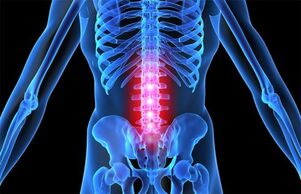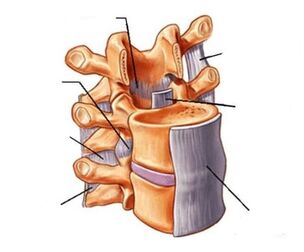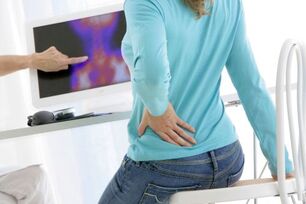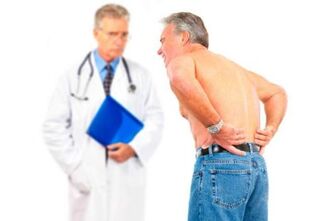A significant amount of a person's weight falls below the waist, and when lifting a load, additional stress is created when bending from a long static position. Excessive load, the wrong lifestyle constantly leads to the degradation of the musculoskeletal system: the vertebrae and discs, which act as a shock absorber between them. From now on, lumbar osteochondrosis: symptoms and treatment are worth looking for. Why does degeneration of the lumbar joints occur?

Degradation of the musculoskeletal system occurs as follows: the natural shock absorber of the spine loses its elasticity, shrinks, spreads beyond its natural limits, the pressure from other vertebrae, organs and ligaments increases. Let's describe those who are prone to such a pathological gain. Osteochondrosis of the lumbar spine can be observed in humans:
- The first generations suffered similarly;
- Presence of hormonal diseases;
- Individual predisposition to the development of such diseases (for example, the congenital structure of the spine);
- Those who neglect proper nutrition. Every day at the table, a person should get a diet balanced with healthy fats, vitamins, proteins;
- Those who have a sedentary job: sit for a long time or stand in one place for a long time;
- Living a sharp and heavy load on the spine, for example: weightlifters, loaders, people during gardening;
- Digestion, metabolism, diseases of the pelvic organs;
- Traumatized (pulled too hard from behind, hit sideways, fell, bent);
- Reached the age of 30;
- Diabetes.
If you have symptoms of osteochondrosis of the spine described in the following section, some habits should be avoided:
- confusing;
- smoke;
- take a long bent pose;
- move a little;
- to drink alcohol;
- to sit at work without a break;
- Not suitable for the weather, allow the body to cool.
Important. Any disorder in the gardens is aggravated by excess weight. Excess weight increases the load on the underside of the body, and the fat-increased lumbar region is heavily massaged.
Stages of the disease, symptoms

Initially, there are periodic mild pains that increase with physical strength. This concern indicates that it is time to focus on lumbar osteochondrosis. Currently, the intervertebral discs (the spinal column is the channel through which the spinal cord and the surrounding fibrous ring pass). In addition, the distance between the vertebrae is reduced, the nerves are compressed. The pain is exacerbated, affecting not only the back, but also the hips and gluteal muscles. In the third stage, the fibrous rings are destroyed, which leads to the formation of a hernia, irreversible bending and constant pain. The fourth stage leads to disability. The specific classification of lumbar osteochondrosis includes:
- pain;
- ischemic syndrome;
- radicular syndrome;
- vertebral syndrome;
- ossification of enlarged tissues.
Pain sensations have different degrees and severity: lumbago, for example, is called lumbago; persistent, aggravated by stress, lumbodynia; The spread along the lower parts of the body is called lumboischialgia, and if left untreated, lumbar vertebrae can move very freely in the spine. When lifting weights and sharp movements, there is a contraction in the nerve roots, then the pain from the waist passes, but passes to other parts of the body, for which the nerve is responsible. Unconsciously, we change the situation, so there is less pain in our back, but at the same time, gait and lumbar flexion inevitably change. All of this refers to a radicular syndrome that begins as an irritation and then becomes inflamed. Signs of lumbar osteochondrosis with radicular syndrome:
- The back muscles are extremely tired;
- change the back curve;
- gait changes;
- swelling of the lower extremities;
- pain in one or both legs;
- severe pain;
- temporary loss of foot sensitivity;
- periodically prolonged constipation;
- men have anxiety problems;
- menstrual disorders in women;
- intoxication of the body;
- blood stasis.
You may notice that painful sensations appear during breaks and decrease during back exercises. It is already worth looking for a doctor at this stage: Chiropractor, surgeon, neurologist, traumatologist (because the causes of osteochondrosis of the spine are trauma). If you allow the disease to progress, the problem will increase, supported by different satellites:
- heat;
- keylik;
- sweating;
- crackle;
- chills;
- gas bubbles;
- impotence;
- intestinal colic.
The back muscles lose tone, which leads to a total loss of human motor function. Paralysis will occur with a particularly dangerous course of radicular syndrome. Ischemic syndrome is associated with radical. Initially, the compression of blood flow is periodic, but then such compression causes spasms. You can see this during normal walking - you walk in pain, it does not hurt if you stop. The main degradation occurs inside and is not visible to the naked eye - it does not provide the necessary supply of blood to all pelvic organs. There may be pain in the buttocks, and then there may be paralysis of the gluteal muscles. Vertebral syndrome already includes changes in the skeleton, the blood vessels themselves.
Important. Symptoms of lumbar osteochondrosis in women are inextricably linked with hormonal levels and physiological features of the body. Wearing shoes that are not suitable for the formation of pain, improper posture affects: too hard or too soft soles; a very high heel or a very low heel.
Diagnosis of stages of the disease

During an external examination, it can be very difficult for a doctor to classify and name the disease. Initially, a neurologist can make a diagnosis:
- continuous curvature of the spine;
- pain when touched;
- decreased foot travel;
- asymmetry of the gluteal zone;
- Michaelis diamond change.
But the most accurate diagnosis can only be made with results:
- computed tomography (CT). It is the most optimal choice for determining the degree of disease development, which allows you to assess the stage of degeneration of the spine.
- X-ray. According to them, it is possible to determine the presence of a disease, but it is not always possible to determine the degree of development of damage to nerve fibers and blood vessels.
- magnetic resonance imaging. It is a very long (from half an hour to an hour) expensive procedure that provides the most complete detail of what happens to the nerve roots and blood vessels.
Thus, the doctor can finally rule on osteochondrosis of the lumbar spine: symptoms and treatment only with the results of hardware studies. Low back pain that is not related to an intervertebral disc disorder is caused by a cold, chills, menstrual cramps, or back pain.
Important. CT and X-ray examinations are not acceptable for pregnant women. CT is dangerous for: 1) children under 14 years of age; 2) People with iodine allergies.
Medical treatment
The causes and features of the onset of the disease, discussed above, now move on to the second point of osteochondrosis of the spine: symptoms and treatment. The more you ignore the body's signals, the faster the disease will go. The more from the beginning, the more drugs and procedures should be applied. Treatment goals:
- identifies and eliminates the causes of constriction of the spine, roots, arteries;
- to restore skin sensitivity; to prevent further development of pathology
- ;
- start the body's processes for self-healing;
- to strengthen a person's muscle tone;
- to restore the function of the internal organs of the small pelvis;
- Return the normal course of the spine.
If you feel any discomfort, consult your doctor. The first things to look for at the first symptoms are: bed (a wide selection of orthopedic mattresses to choose from individually), pillows (size and softness may not suit you), sleeping position, motor movement. At home, lumbar osteochondrosis is treated only with bed rest without a doctor's examination. Therefore, it is mandatory to consult a doctor. Different medications are taken in the remission phase and in the acute phase of the disease. In the latter stage, medications are used to reduce pain, relieve nerves from vertebral ticks, and eliminate inflammation. Identify: - blockades; - glucocorticoids; - chondroprotectors; - myo-laxatives; - Non-steroidal anti-inflammatory drugs (NSAIDs).

The latest group of drugs, in addition to reducing pain, fights overheating, edema, inflammation. Such funds can be: rectal, for internal use, injection, external. Treatment of lumbar osteochondrosis usually begins with NSAIDs:
- Diclofenac;
- Piroxicam;
- Ibuppofen;
- Himekulid;
- Hapoksi;
- Dekketoprofen;
- Meloxicam;
- Aceclofenac.
The anti-inflammatory drugs on this list are various ointments, tablets, gels. Some tablet NSAIDs are contraindicated for people suffering from ulcers or gastritis. The muscle relaxant temporarily reduces muscle tone and eliminates joint stiffness and involuntary contraction of the back muscles. This group of drugs includes tizanidine, tolperisone hydrochloride. When there is an opportunity to save the intervertebral disc, chondroprotectors are prescribed to restore the ring fibrosis. Such a group of drugs is very long - at least 1, 5 months, and the results can be seen only after a year. Because this group of drugs belongs to steroid hormones, they try to avoid prescribing glucocorticoids because there are side effects of taking them. All prescriptions should be taken under the supervision of the attending physician, because only a specialist knows how to treat lumbar osteochondrosis. An example of such a drug is hydrocortisone. Obstruction is not a cure in itself, but a powerful painkiller. The technique is as follows: Inject an analgesic (IO) or IO combination with a drug from the group of glucocorticoids in the area of pain. Blockages do not have therapeutic properties, but can be addictive, which can lead to loss of sensitivity to these drugs. If injected too often, the muscles around the injection become atrophied. Therefore, when acute pain is reduced with this treatment, the patient is prescribed medications that help restore damaged tissue, blood flow, and improve the tone of muscle and nerve fibers. This is:
- Chondroprotectors, which have a general strengthening effect on bone tissue, normalize the metabolism of cartilage tissue.
- Vitamins that help restore nerve conduction.
- Biogenic drugs that promote the body's self-improvement;
- Vascular drugs that thin the blood to improve the nutrition of the internal organs.
During treatment, antidepressants are prescribed along with the main medication. How to treat osteochondrosis of the spine by reducing acute pain:
- apply warming, analgesic, anti-inflammatory foreign substances;
- Do special exercises for the back;
- get a massage;
- lead a moderate lifestyle for the back;
- Wear a belt corset while exercising.
Massage, physiotherapy exercises, physiotherapy and alternative therapy.

Relatively cheap and effective methods against shock absorber degradation are physiotherapy exercises, massage, physiotherapy. True massage can be done only by a specialist with medical education, so a simple visit to beauty salons is not suitable for patients. Each stage of the disease requires a different pressure and technique. With proper therapy, muscle spasms disappear, the lumbar muscle frame is strengthened, and the pain gradually disappears. Physiotherapy is used only in the process of weakening or absence of painful processes (to maintain the mobility of the vertebrae). Gymnastics is selected individually based on the person's age, condition and stage of the disease. The productivity of therapeutic exercises directly depends on the quality and frequency of performance: they must be carried out systematically. It is recommended to sleep at home, lie on your back, bend your legs, put a small roller under your waist. The healing process is monitored by X-ray and tomographic examinations. Physiotherapy treatments are prescribed during remission and exacerbation. Methods such as:
- acupuncture. An ancient method of treating pain based on stimulating acupuncture points with fine needles. The procedure eliminates spasms, reduces pain, completely eliminates, reduces tissue edema;
- ultraviolet radiation that stimulates the body's absorption of calcium;
- ampilpus, named after the corresponding device. The treatment procedure is as follows: the plates of the apparatus are fastened to the back and the corresponding therapeutic current with different parameters flows through the plates;
- laser therapy. Laser rays relieve pain, heal, stop inflammation in the spine;
- darsonvalization. The method is designed to improve blood circulation, dilate blood vessels, stimulate nerve endings;
- phonophoresis is treated with ultrasound, which stimulates blood flow to the muscular part of the dorsal region.
Each method has its own contraindications. It is more difficult with traditional medicine. Official medicine still does not know how midwives know how to treat osteochondrosis of the spine. Therefore, if a friend advises you to apply compresses made with burdock juice, take candle baths, you should consult your doctor. A method such as hirudotherapy is used to reduce pain, but aqueous crops are hidden behind the name, so doctors advise caution in this method of treatment.
Surgical problem solving
In some cases, it is no longer possible to do without surgery. In advanced intervertebral hernias, neurosurgeons use microdiscectomy. The operation removes the damaged disk. If there are no contraindications, doctors can perform nucleoplasty, which has many advantages:
- no interruptions required;
- operation lasts up to 30 minutes;
- There are no restrictions for surgical procedures.
Important. It is recommended to do yoga, swimming, Pilates to maintain the mobility of the spine, strengthen the muscles of the spine. Running creates a shock load on the vertebrae, so running should be avoided at the first sign of back pain.













































